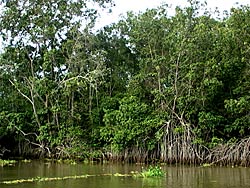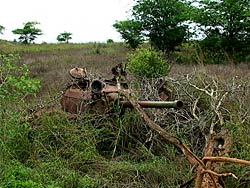|
Biodiversity in Angola - Reintegration and Conservation |
 Richness in Biodiversity Richness in Biodiversity
Angola possesses a unique wealth in regard to biodiversity, proven by the presence of the Giant Sable Antelope and the Welwitschia mirabilis, symbols of the Angolan identity. Furthermore there is vast wealth of forest life with more than 5000 species of plants, more than 275 species of mammals and an avifauna composed of 872 categorized species. This exceptional biodiversity is due to a combination of various factors namely; the vast dimension of the country, its inter-tropical geographical location, variation in altitude, and the type of biomass.
The climactic diversity combined with a similarly geologic and soil variety, contributes to the formation of bio-climatic zones such as the dense tropical forest to the lack of vegetation in the desert. These different habitats favor the high level of biological diversity. Habitats such as the Maiombe forest boast an enormous and wealthy variety of animals and vegetation which constitute a heritage of international value, a fact that contributes to the trafficking of these species to overseas countries.
The Direction of the National Strategy
With the objective of protecting this vast and rich biodiversity, the Angolan Government approved in 2006 a National Strategy for the Conservation of Biodiversity which has as its main objective the incorporation of conservation and sustainable use of the biological diversity means as well as equitable and fair distribution of biological resources, into the policies and programs of development so that they may benefit all Angolans.
This Strategy and its Plan of Action are interconnected through eight strategic areas which among others include Researching and Publishing of Information, Management of Biodiversity in Environmentally Protected Areas and the Sustainable Use of Biodiversity Components. In light of the Strategy’s recommendations numerous actions towards management and conservation of biodiversity have been implemented, of which the following ones have been highlighted - rehabilitation of the infrastructures of the National Parks of Cangandala, Quiçama, Bicuar e Iona, the Conservation Project of the Giant Black Palanca as well as initiatives for the creation of Trans boundary conservation areas in the Southern African region.
New Perspectives for Conservation
The peace period that has been reached in Angolan since the April 2002 cease fire, brought new perspectives for the processes of reconstruction and national reconciliation as well as a social stability which is vital for the preservation of peace. The majority of refugees, dislocated and demobilized soldiers returned to their home lands in search of better conditions and to reunite with their families.
This peace period, also brought with it opportunities to ensure the protection of the biodiversity’s potential, to combine the component of biodiversity with the issues of professional training and reintegration of ex-soldiers in the management of conservation areas.
Biodiversity Conservation and Management
In this matter the Ministry of Town Planning and Environment with the aid of the German Technical Cooperation (GTZ) and in partnership with the Institute for Socio-Professional Reintegration of ex-soldiers, is implementing a project which reconciles the institutional support for conservation and biodiversity as well as the professional training and capacitating of human resources.
This project’s main objective is to reinforce and improve the management and inspection of conservation areas in Angola through human resource training and reintegration of ex-soldiers into the process of rehabilitation and management of the biodiversity in Angola.
The Plan of Action of the project also includes the construction of a School for Training of Park Inspectors and Managers in the Quiçama National Park which will contribute to the development of technical and human capacity as to better manage the Angolan biodiversity.
The main activities of the project will include the training of managers for the conservation areas in Angola, training of inspectors for the Quiçama National Park, south-south exchange with Angola and Brazil, and the rehabilitation of infrastructures.
|